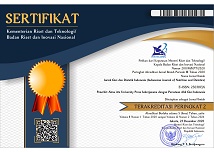Relationship between sodium, calcium, and preeclampsia during pregnancy : a Cross-sectional study
Abstract
ABSTRACT
Background: In the world maternal mortality as many as 830 women died due to complications in childbirth. In 2015, 303.000 women died during pregnancy and after pregnancy. Target Sustainable Development Goals (SDGs) year 2030 lowers MATERNAL MORTALITY RATE under 70 per 100.000 live births. Pregnancy complications can cause bleeding before or after childbirth, preeclampsia, eclampsia, infections, and others. Maternal death case in Kab. Bantul in 2015 is 9 cases. Research Data in the Panembahan Senopati Hospital in the year 2017 the incidence of childbirth with complications of 1068 people. The prevalence of preeclampsia in expectant mothers is 176 people by 16.47%.
Objectives: This research aims to know the relationship of sodium and calcium consumption in the mother of Nifas with preeclampsia during pregnancy in the Panembahan Senopati Hospital. Number of Samples were 54 postpartum women in Panembahan Senopati Bantul. Processing and analysis of data using the Chi-square test.
Methods: This type of research is an analytical observational, with a research design using a cross-sectional.
Results: Characteristics of most respondents in the age category of 20-35 years as many as 38 people (70.4%), education graduated of senior high school 28 people (51.9%), history of not hypertension as many as 51 people (94.4%) and has no preeclampsia history as much as 50 people (92.6%). Statistical test results of Chi-square and p-value sodium was 0.564 (> 0.05) and P-value calcium was 1.000 (> 0.05).
Conclusion: There is no relationship between sodium and calcium consumption of postpartum women with preeclampsia problem during pregnancy at Panembahan Senopati Hospital.
KEYWORDS: calcium, preeclampsia, sodium
Full Text:
PDFReferences
WidiastutI, R. O, 2018. Hubungan Konsumsi Suplemen Kalsium yang Kurang Selama Kehamilan Sebagai Risiko Kejadian Preeklampsia di Rumah Sakit Umum Daerah (RSUD)Kota Agung Kabupaten Tanggamus http://digilib.unila.ac.id/32584/3/skripsi%20tanpa%20pembahasan.pdf 30 Juli 2019
SDKI 2012. Survey Demografi dan Kesehatan Indonesia 2012. http://www.chrl.org/pelatihan-demografi/SDKI.2012(Diakses pada tanggal 08 November 2017)
World Health Organization (WHO). 2015. Maternal Mortality.http://www.who.int/mediacentre/factsheets/fs348/In/(Diakses pada tanggal 08 November 2017)
SDGs 2015. Kesehatan dalam Kerangka Sustainable Development Goals (SDGs). http://sdgsindonesia.or.id/index.php?option (Diakses pada tanggal 08 November 2017)
Profil Kesehatan Bantul 2016.
http://dinkes.bantulkab.go.id/filestorage/dokumen/2016/08/narasi%20profil%202016.pdf. (Diakses pada tanggal 08 November 2017)
Cuningham F.G. Gant. NF. Leveno. K.J. Glistrap. L. C. Haut J. C. Wenstrom. KD. 2011. Obstetri Williams. Jakarta : EGC.
Nuryani. Ade Annisa Maghfirah. Citrakessuma Sarit, Sriah Alharini. 2013. Hubungan Pola Makan, Sosial Ekonomi, Antenatal Care, Karakteristik Ibu Hamil dengan Kasus Preeklampsia di Kota Makassar. Vol. 2, No. 2, Agustus 2013 : 104-112
Sutrimah, Mifbakhuddin, Dwi W., 2015. Faktor-faktor yang berhubungan dengan kejadian Preeklamsia pada Ibu Hamil di Rumah Sakit Roemani Muhammadiyah Semarang.
http://download.portalgaruda.org/article.php?article=314030&val diakses tanggal 02 juni 2018.
Andriani, M. Bambang, W. 2012. Peranan Gizi dalam Siklus Kehidupan. Jakarta : Kencana Prenada Media Grup.
Winda, Y. 2015. Analisis Faktor-Faktor Risiko yang mempengaruhi Terjadinya Preeklamsia atau Eklamsia di RSU PKU Muhammadiyah Yogyakarta Tahun 2007-2009.http://digilib.unisayogyakarta.ac.id. Diakses tanggal 02 Juni 2018.
Ghojazadeh, M., Azami-Aghdash, S. Mohammad, M., Vasoogh, S., Mohammad, S., Naghavi – Behzad, M. 2013. Prognostic Risk Factor for Early Diagnosing of Preeclampsia in Nullipara. Nigerian Medical Journal, 54 : 344-8.
Marmi dkk. 2016. Asuhan Kebidanan Patologi. Yogyakarta : Pustaka Pelajar.
Nuning, S. Mardiana. 2016. Faktor Risiko yang berhubungan dengan Kejadian Preeklamsia pada Ibu Hamil (Studi Kasus di RSUD Kabupaten Brebes Tahun 2014). http://journal;unnes.ac.id/sju/index.php/ujph Diakses tanggal 02 Juni 2018.
Dyaanggari, S. 2015. Analisis Perbedaan faktor Risiko dengan dan Tanpa Riwayat Preeklamsia. http://eprints.undip.ac.id/46835(Diakses pada tanggal 28 Januari 2018)
Khoerunisa, Z. Fatimah. Eka, N. 2016. Hubungan Pola Konsumsi selama Hamil dengan Riwayat Preeklamsia pada Ibu Nifas (KTI).
Lusi A. K., Effatul A., Isti S. 2016. Asupan Lemak dan Aktivitas Fisik serta Hubungannya Pada Pasien Rawat Jalan. Skripsi
Afifah, E. 2016. Asupan Kalium-Natrium Status Obesitas sebagai Factor Kejadian Resiko Hipertensi Pasien Rawat Jalan di RSUD Panembahan Senopati Bantul Yogyakarta. JGDI, Vol. 4, No. 1, Januari 2016 : 41-48. https://ejournal.almaata.ac.id/index.php/IJND/article/view/327
Susmala D, T. Yulinda K. Arinto H. 2017. Hubungan Asupan Natrium dan Asupan Lemak Terhadap Kejadian Hipertensi pada Lansia di Balai Panti Sosial Tresna Werdha Unit Budi Luhur Kasongan Bantul Yogyakarta. Skripsi.
Hasanah U. Effatul A. Esti N. 2017. Hubungan Antara Asupan Kalsium dan Magnesium dengan Kejadian Hipertensi pada pasien Rawat Jalan di RSUD Panembahan Senopati Bantul. Skripsi.
Kumala M, 2014.Peran Diet dalam Pencegahan dan Terapi Hipertensi Role Of Dietary In The Prevention And Treatment Of Hypertension. Volume 13 No. Tahun 2014 http://ojs.atmajaya.ac.id/index.php/damianus/article/view/208
DOI: http://dx.doi.org/10.21927/ijnd.2019.7(1).31-36
Refbacks
- There are currently no refbacks.

This work is licensed under a Creative Commons Attribution-ShareAlike 4.0 International License.
Indonesian Journal of Nutrition and Dietetics (IJND) indexed by:
 View My Stats
View My Stats



12.png)


























